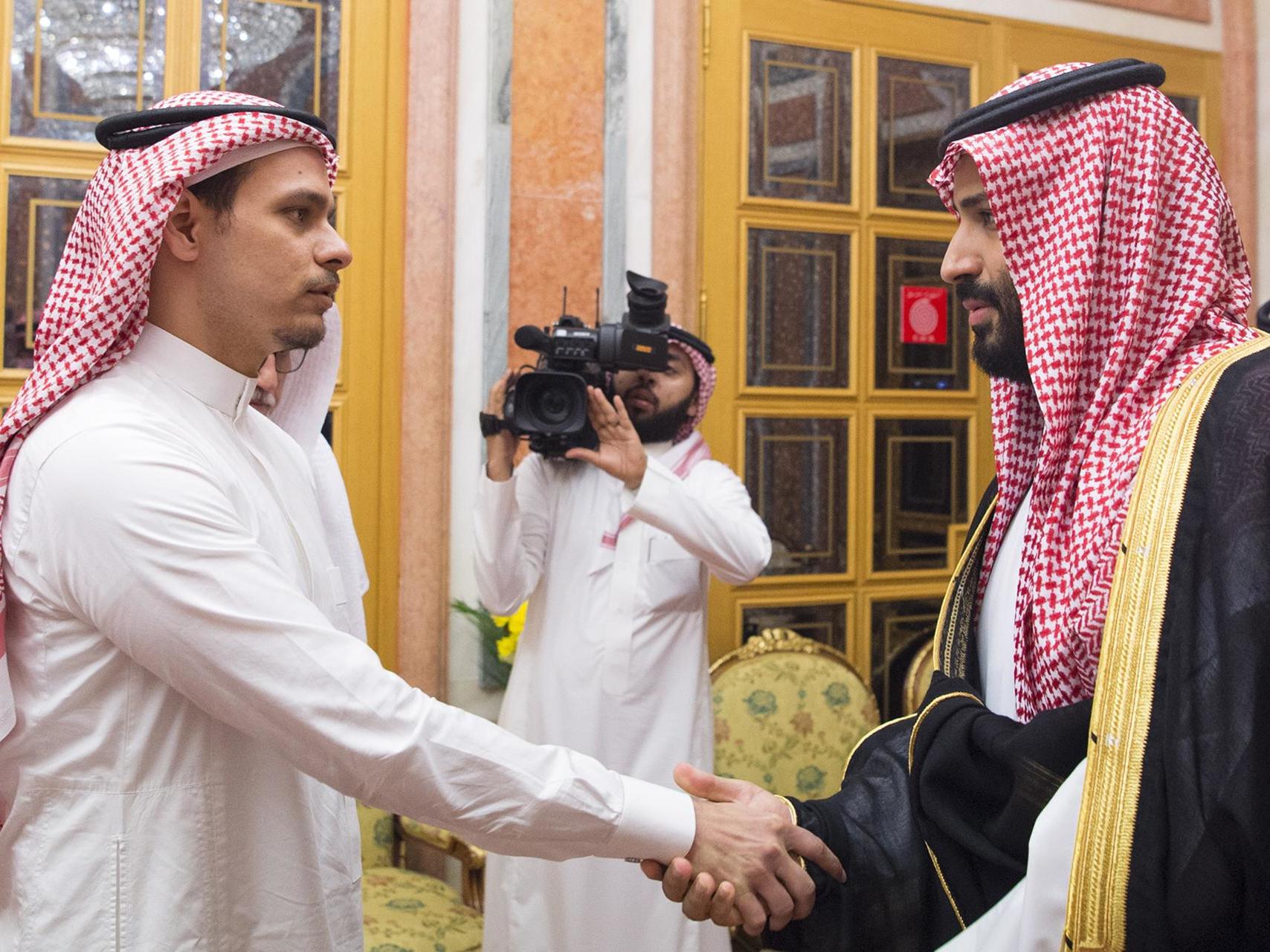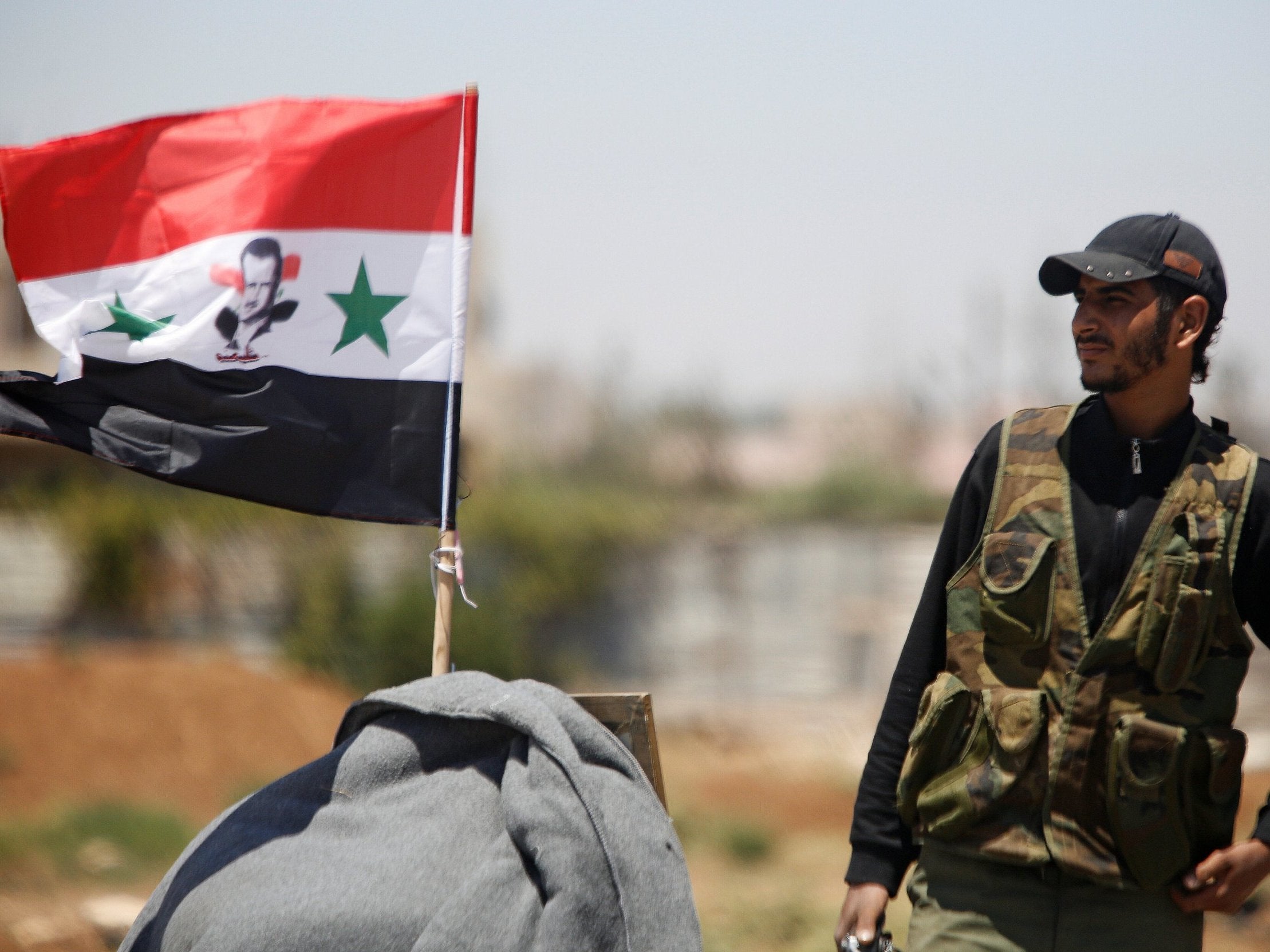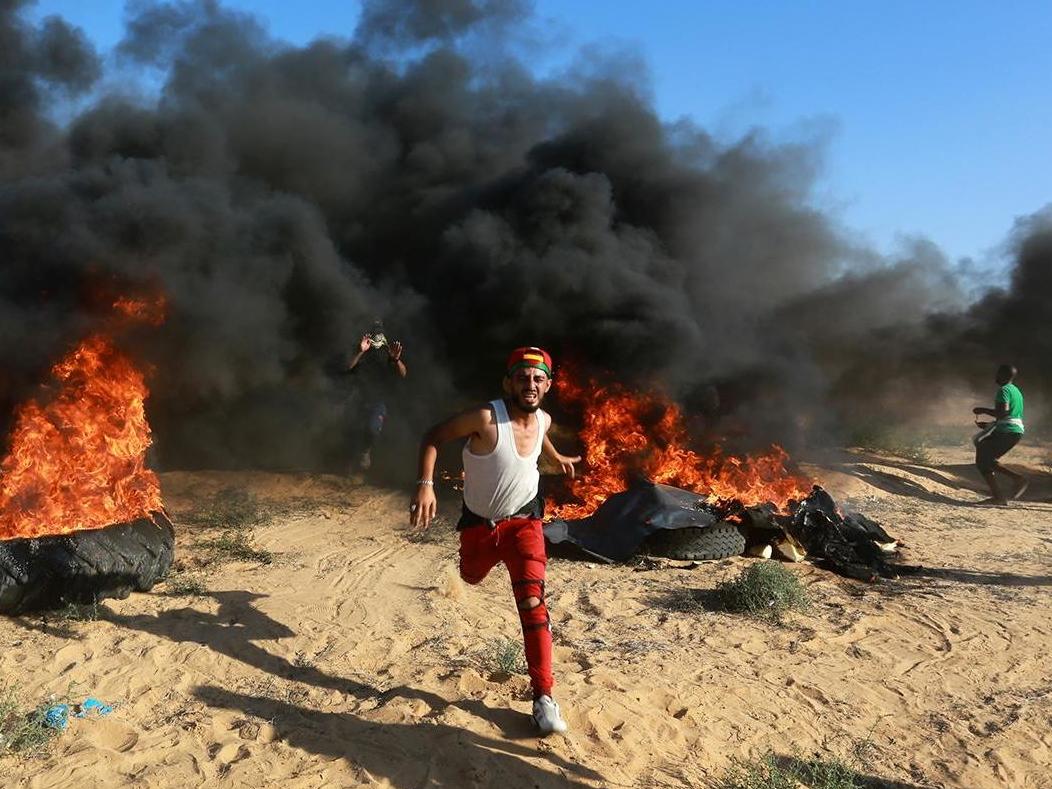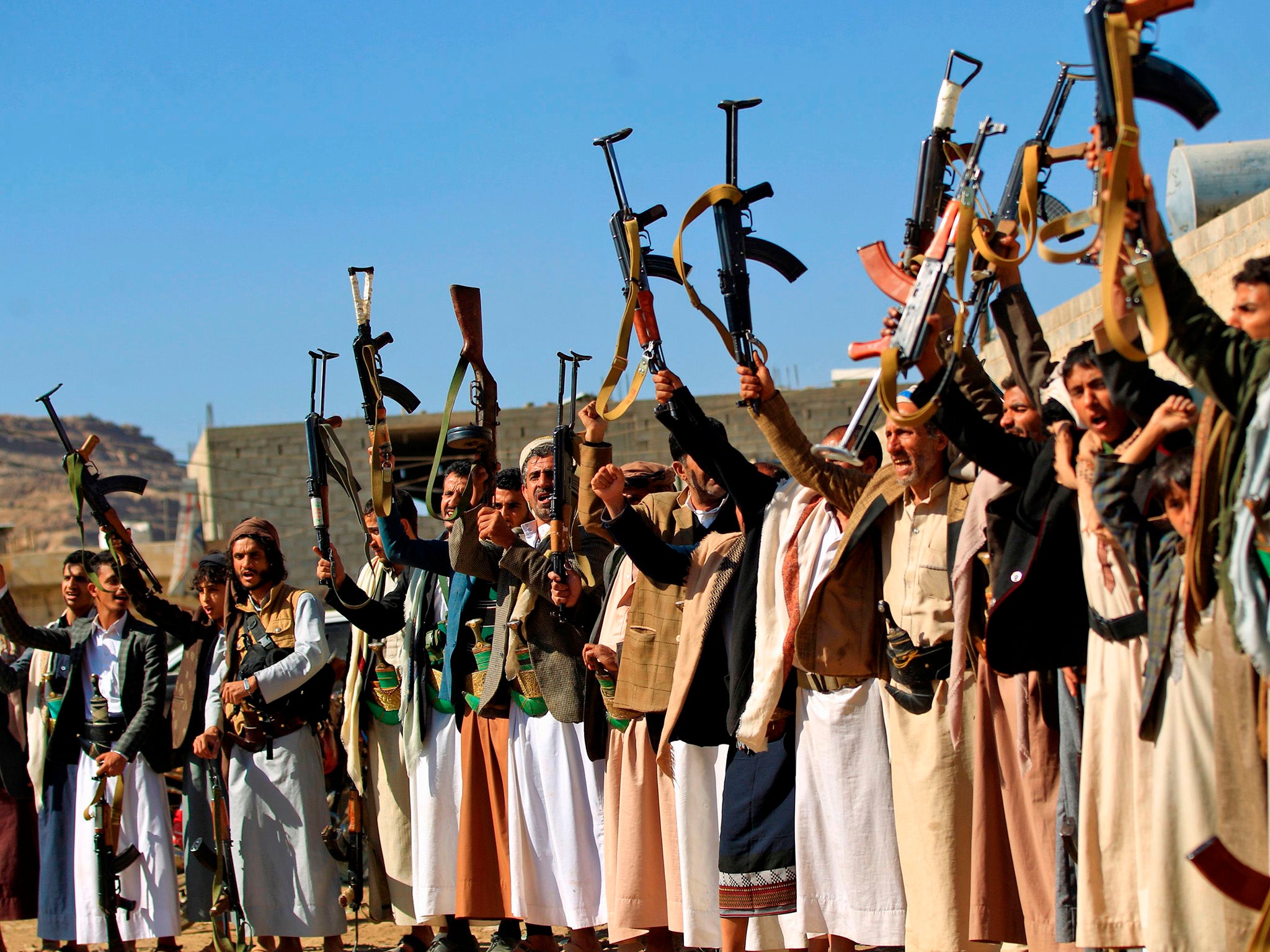The crown prince and Khashoggi murder: When the camel falls, the knives multiply
Saudi Arabia’s suspected involvement in the murder of journalist Jamal Khashoggi has led to shockwaves in the Middle East and around the world, Bel Trew reports


At first glance the image, which encapsulates one of the most important and cataclysmic ruptures in the Middle East in 2018, could be dismissed as a standard Gulf photo op. Two men, one in a flowing thobe (an ankle-length Arab garment), the other in a glittering bisht (a traditional men’s cloak popular in Arab countries), shake hands in an opulent hall as a cameraman, centre-stage, captures the moment.
The picture, taken in October, is in fact just that: a photoshoot. Designed to silence a crescendo of allegations against the powerful Crown Prince Mohammad bin Salman, the official photo went viral for all the wrong reasons. The image is of Salah Khashoggi, 35, the son of slain Saudi columnist and dissident Jamal Khashoggi, shaking hands with the crown prince, the very man believed to have ordered his father’s murder.
At the time it was three weeks after his father, a Virginia resident, had disappeared into the Saudi consulate in Istanbul: his body, according to the Turks, may have been dissolved in acid. Salah, under a travel ban in the kingdom, was summoned to the palace to receive “condolences” for his father’s death from Mohammad bin Salman who the CIA concluded orchestrated the murder, despite vehement denials from Riyadh.
Salah appears simultaneously ashen-faced and defiant – his white robe is suspiciously dishevelled. His hand is awkwardly thrust out towards the Saudi leader.
“The look on his face. This photo makes me want to scream and throw up,” wrote Manal al-Sharif, a prominent Saudi human rights activist now living in self-imposed exile after years of campaigning for women to be able to drive in the kingdom. She warned Khashoggi’s murder threatened the safety of all Arab dissidents abroad.
Fadi al-Qadi, another human rights defender, said: “Ruthless. Ruthless. Ruthless.”
Shockwaves from the torture and violent murder of Khashoggi by top Saudi officials swept through the kingdom, the Middle East and the world. Geopolitical alliances were ripped apart, unlikely foes were united, western leaders had to question everything from their military alliances to arms sales.
For the first time in three years the murder shone a spotlight on Saudi’s ruinous war against the Iran-backed Houthis in Yemen, which the crown prince, as defence minister, had arguably started and which the United Nations said caused the world’s worst humanitarian crisis.

Neither the Libyan militia murder of Chris Stevens, the US ambassador to Libya, in 2012 nor the torture and murder of Italian student Giulio Regeni in Egypt in 2016 had such an impact. For it came at a time of systemic shift in the region. This year marked the history book’s closing chapter on the Arab Spring, which for seven years had dictated the events of the region and had broken and forged key alliance’s around the world.
Now Israel, Palestine, Lebanon, Iraq, Saudi Arabia and Yemen, as well as Iran, the US, and the Kurds, the old-school conflicts of the late 1990s and early 2000s, buried or muffled by the 2011 uprisings, were bubbling up again. And so the blast was so keenly felt experts argued that Khashoggi’s killing had a bigger impact on Saudi’s western ties than the 2001 September 11 attacks.
“9/11... about 15 of the 19 hijackers were Saudis, but they were Saudi rebels,” wrote Washington-based Middle East expert Simon Henderson in November. “They were against the regime. This, at least according to current reports, would appear to be the Saudi government itself – this is huge.”
It did not help that Turkey, a sporadic ally of Saudi Arabia in the region, refused to back down. Recep Tayyip Erdogan, the Turkish president, stage-managed the drama with a continuous stream of gory leaks, despite being a country itself infamous for the poor treatment of dissidents and journalists.
Western leaders, meanwhile, who had placed their hopes in the crown prince as a key moderate Muslim reformer in the region, were forced to re-evaluate their relationship. Donald Trump, who vowed to stick by Mohammad bin Salman, was arguably the biggest casualty of this. Earlier this month, in a stunning move, the Senate defied Trump, passing a resolution saying the crown prince was responsible for Khashoggi’s murder.
The measure, endorsed by at least 10 Republicans, also concluded there was no good reason the US was backing the war in Yemen. This marked first time any chamber of congress backed a move to withdraw US forces from a foreign military engagement under the War Powers Act. Even Republican Senator Lindsey Graham, a Trump ally and one-time supporter of the US-Saudi alliance, said you would have to be “wilfully blind” not to see the crown prince’s involvement.
Back in the kingdom, several wings of the House of Saud, increasingly sidelined by the upstart prince who detained more than 200 royals and businessmen on corruption charges last November, were apparently agitating to prevent the crown prince from becoming king. At the close of 2017 this would have been an impossibility. But as the Arabic saying goes: when the camel falls, the knives multiply.
Final chapter of the Arab Spring
Saudi Arabia and Yemen aside, what was noticeable in 2018 was the gathering quiet around Syria, and other Arab Spring countries, whose revolutions have effectively died.
At the start of the year, Egypt’s former military chief Abdel-Fattah al-Sisi secured a second term in office with 97 per cent of the votes in a March election where his sole challenger was a supporter of his campaign.
Under Sisi’s rule, tens of thousands of regime opponents have been locked up, protests banned and civil society and a free press crushed. This correspondent herself, a long-term Cairo resident, was arrested and deported in February.
Mid-December, an Egyptian court agreed to hear a challenge to the two-term limit for the presidency, paving the way for someone else to rule as long as Hosni Mubarak did (30 years). If passed, the 2011 Arab Spring demands of bread, freedom and social justice will likely remain indefinitely unanswered.

Meanwhile, in Syria the death knell of its revolution was sounded in July when rebels and jihadis agreed to surrender the southern province of Deraa: birthplace of the revolt and one of the two remaining opposition strongholds left. Backed by Russian forces and warplanes, Syrian president Bashar al-Assad had raged through his country with an effective strategy of chemical attacks, intense bombardments and evacuation agreements.
Corralled into Idlib, in the north, the hodgepodge of opposition forces has only been spared a final bloody regime offensive by hasty intervention from international actors – including the newly emboldened Erdogan, who in 2017 won a referendum that awarded him sweeping new powers, and in June he claimed victory in a general election. And as if a poignant symbol of that, Raed Fares, one of Syria’s best known and loved activists, was gunned down in November in the northwestern town of Kafranbel.
President Trump’s last-minute December decision to withdraw US troops from Syria, after controversially declaring that Isis had been defeated, was another sign the west had moved on and was untangling itself from a dying Arab Spring. It also heralded the resurgence of a conflict between Arab and Kurdish forces. The withdrawal left the US’s main partner in Syria, the Kurdish-dominated Syrian Democratic Forces, without international protection from Turkey, which had threatened cross-border attacks against them.
In 2018, Libya became an afterthought, after its branch of Isis was defeated last summer and a flood of migrant boats to Europe was stemmed due in part, many say, to dodgy payouts by Italians and French to local warlords. Instead the world appeared to abandon the north African country to a nightmarish militia la-la-land. The UN-backed Libyan government lost control of the capital a few times over the course of the year. The hopes of any election in 2018 were never realised.
In place of the Arab Spring there seems to be a winter of familiar conflicts from the past.
Return to the 2000s
In Israel, the events of the year were partly anchored in Trump’s December 2017 decision to move the US embassy from Tel Aviv to Jerusalem, thereby recognising the contested city as Israel’s capital. It sparked a chain of events which left many, by the close of the year, speculating yet again whether we were on the verge of a third Intifada.
In reaction to the embassy announcement, Palestinians in Gaza launched the Great March of Return. Since spring, tens of thousands of Gazans have marched towards the border fences with Israel – demanding an end to the 11-year-long Israeli-imposed blockade and the right to return to ancestral lands they were forced from or fled during the 1948 conflict which surrounded the creation of Israel.
More than 200 Palestinians have been killed by Israeli fire, and tens of thousands wounded. The Israelis have defended their actions, saying protesters repeatedly attacked the borders and flew burning kites and balloons with explosives into Israel.

A fourth war between Gaza and Israel was nearly declared multiple times, and in November Benjamin Netanyahu’s government was on the verge of collapse. But arguably the most worrying break from the normal cycle of violence – and where the ghosts of an Intifada emerge – was in an uptick in attacks in the occupied West Bank.
Between October and December, across multiple shootings in or around Israeli settlements, Palestinians killed two Israeli civilians, two soldiers, and injured several others including a pregnant woman who lost her baby.
Hamas, the militant group that runs Gaza, claimed two of the West Bank gunmen as their fighters, causing multiple problems for Hamas’s rivals Fatah, which dominates the Palestinian National Authority. The authority was forced to stand aside as Israel launched mass arrests and raids across West Bank cities. Palestinian security forces, meanwhile, were filmed battling Hamas supporters in Hebron and Nablus, to stop them rallying.
Iranian ‘threat’
Even the ghosts of the Israel-Lebanon conflict appeared at the end of 2018. In December Israel launched a massive operation to destroy cross-border tunnels built by Hezbollah, heightening tensions. After seven years fighting in the Syrian civil war, the Lebanese militant group has come out of it battle-hardened with a massive arsenal, reportedly provided by Iran whose forces are increasingly entrenched in Syria.
The US withdrawal from war-ravaged Syria, meanwhile, worried many in Israel who fear it could pave the way for greater Russian and Iranian influence just across Israel’s borders.
The perceived expansion of Iranian influence in the Middle East – whether funnelling weapons to Hezbollah, backing the Houthis in Yemen or building military infrastructure in Syria – saw the US take an increasingly aggressive stance towards Tehran, in echoes of the early 2000s.
Trump tore up the Iran nuclear deal, the tricky brainchild of Europe and the Obama administration, and imposed new sanctions on Tehran, which kicked in last month, tightening the noose on a country hit by domestic protests. This Iranian “threat” has also allowed Israel to edge closer to its Arab neighbours, many of which have no formal diplomatic ties with the country. In October Netanyahu visited Oman’s ailing Sultan Qaboos bin Said, while Israel’s sports and culture minister travelled to the UAE for the first time.
At the close of the year there were even rumours that Crown Prince Mohammad bin Salman was mulling over a meeting with Netanyahu and Trump, possibly to help rehabilitate his image.
Yemen’s simmering south
The crown prince needs support, as all eyes were on Yemen at the close of the year. December UN-hosted talks in Sweden produced a tentative ceasefire deal between the Yemeni government and the Houthi rebels over the strategic port city of Hodeidah. While that promised progress, a little-reported conflict, also grounded in the late 1990s, threatened to scupper it.
Yemen’s southern separatist movement has been buoyed by arms and training from Saudi’s main ally the UAE, who enlisted them to battle the Houthis. Angry they were not invited to the peace talks in Sweden, the Southern Transitional Council once again demanded the south be an independent state, saying there would be “no just peace” until the “southern question” was answered. Yemen, which was only really unified in the mid-1990s, could be on the verge of a new and different civil war.
This will largely depend on which way the UAE goes. Unlike Saudi Arabia, which has focused on airstrikes, the UAE has boots on the ground, and unfurled a little documented but impressive string of military bases along Yemen’s southern coast. Most significantly, it controls bases on both sides of the Bab al-Mandeb Strait – the strategic gateway between Asia and the Mediterranean. Many believe the future of south Yemen will depend on how long the UAE will remain there, and to what end.

Other well-worn conflicts coming to the foreground are unfurling in Iraq. There, old political divides are simmering now that all sides are no longer united in the fight against Isis, which was defeated at the end of 2017 but still controls pockets. The question of what to do with the powerful Shia paramilitaries, formed to tackle Isis, has yet to be answered.
In the north of the country and sweeping into northern Syria, the Kurdish-Arab issue surfaced again. While tensions in Iraq have significantly calmed since the Kirkuk crisis last October, it feels like much of the country is holding its breath to see how the new Baghdad administration, under recently elected Prime Minister Adel Abdul-Mahdi, will fair.
Meanwhile, in northern Syria, Erdogan threatened a new cross-border operation against US-backed Kurdish YPG forces in late December, which Turkey considers a terror organisation and part of the outlawed PKK. The presence of US forces inside Syria was seen as a bulwark against any major Turkish action, but after Donald Trump’s announcement that all American military personnel would withdraw, the threat of a new front opening up in Syria’s war has risen. The US’s Kurdish allies said the withdrawal would threaten the fight against Isis, and said they actually needed “bigger and continuous support” from the west as jihadis were regrouping.
"The decision of pulling back will directly undermine the efforts of the final battle of defeating the terrorists... and lead to a political-military vacuum," the group said.
For the moment, at least, Erdogan’s threats are bark and bluster.
Join our commenting forum
Join thought-provoking conversations, follow other Independent readers and see their replies
0Comments